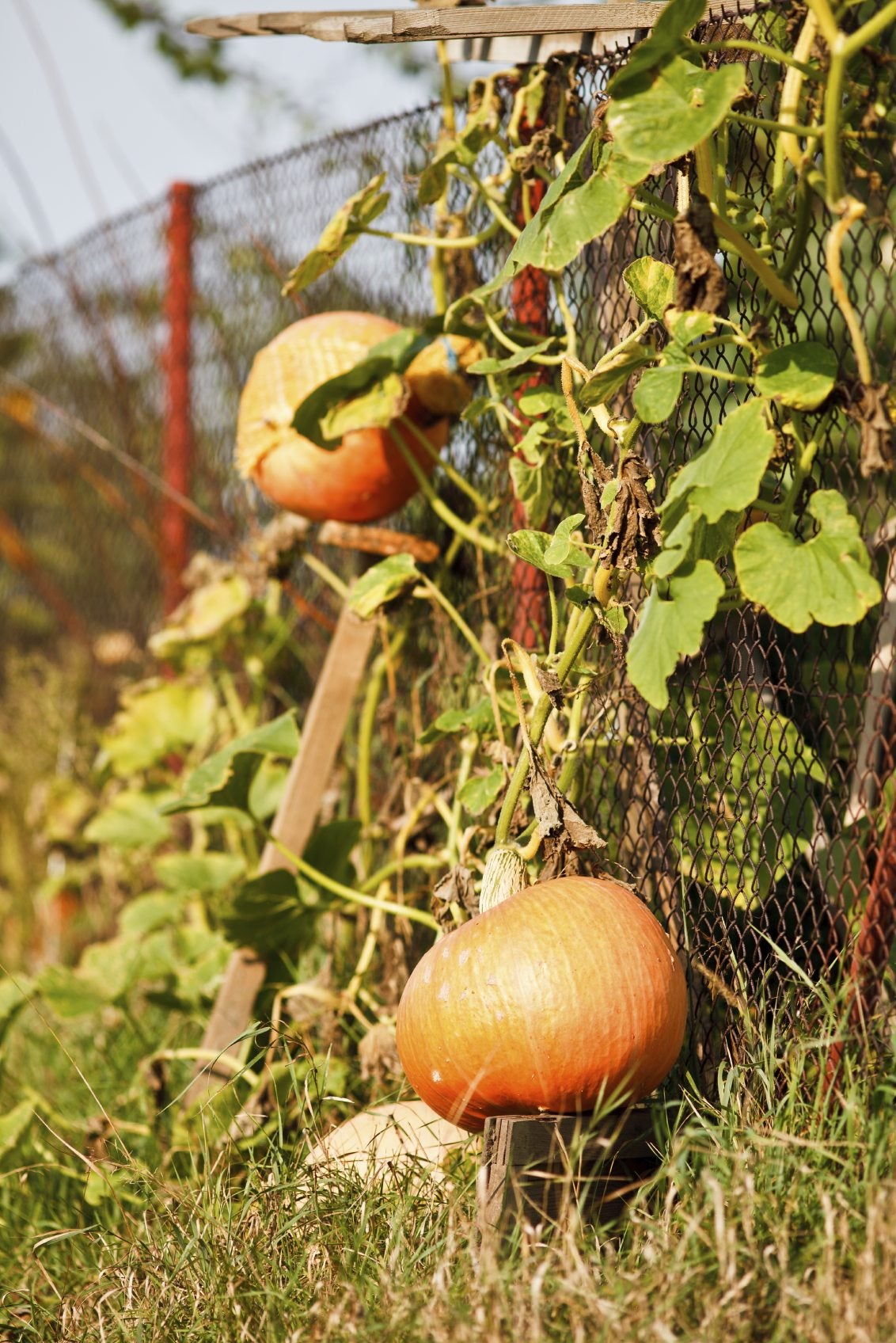Planting A Pumpkin On A Trellis: Tips On How To Make A Pumpkin Trellis

If you have ever grown pumpkins, or for that matter been to a pumpkin patch, you are well aware that pumpkins are gluttons for space. For this very reason, I have never tried to grow my own pumpkins since our vegetable garden space is limited. A possible solution to this dilemma might be to try growing pumpkins vertically. Is it possible? Can pumpkins grow on trellises? Let's learn more.
Can Pumpkins Grow on Trellises?
Oh yes, my fellow gardener, planting a pumpkin on a trellis is not an inane proposal. In fact, vertical gardening is a burgeoning gardening technique. With urban sprawl comes less space in general with more and more compact housing, meaning tiny gardening spaces. For less than ample garden plots, vertical gardening is the answer. Growing pumpkins vertically (as well as other crops) also improves air circulation which impedes disease and allows for easy access to fruit. Vertical gardening works well on a number of other crops including watermelon! Okay, picnic varieties, but watermelon nonetheless. Pumpkins need 10 foot (3 m.) or even longer runners to supply ample nutrition for developing fruit. As with watermelon, the best choices for planting a pumpkin on a trellis are the smaller varieties such as:
- ‘Jack Be Little'
- ‘Small Sugar'
- ‘Frosty'
The 10p ound (4.5 kg.) ‘Autumn Gold' works on trellises supported with slings and is perfect for a Halloween jack-o'-lantern. Even up to 25 pound (11 kg.) fruit can be pumpkin vine trellised if properly supported. If you are as intrigued as I am, it's time to learn how to make a pumpkin trellis.
How to Make a Pumpkin Trellis
As with most things in life, creating a pumpkin trellis may be simple or as complex as you wish to make it. The simplest support is an existing fence. If you don't have this option, you can make a simple fence using twine or wire strung between two wood or metal posts in the ground. Make sure the posts are fairly deep so they will support the plant and fruit. Frame trellises allow the plant to climb up two sides. Use 1 by 2 or 2 by 4 lumber for a pumpkin vine frame trellis. You can also opt for a tepee trellis made of sturdy poles, 2 inches (5 cm.) thick or more, lashed tightly together with rope at the top, and sunk deep into the ground to support the vine's weight. Beautiful metal work trellises can be purchased as well or use your imagination to create an arched trellis. Whatever your choice, build and install the trellis prior to planting the seeds so it is securely in place when the plant begins to vine. Tie the vines to the trellis with strips of cloth, or even plastic grocery bags, as the plant grows. If you are growing pumpkins that will only attain 5 pounds (2.5 kg.), you probably won't need slings, but for anything over that weight, slings are a must. Slings can be created from old t-shirts or pantyhose-- something slightly stretchy. Tie them to the trellis securely with the growing fruit inside to cradle the pumpkins as they grow. I am definitely going to try using a pumpkin trellis this year; in fact, I think I might plant my “must have” spaghetti squash in this manner as well. With this technique, I should have room for both!
Gardening tips, videos, info and more delivered right to your inbox!
Sign up for the Gardening Know How newsletter today and receive a free copy of our e-book "How to Grow Delicious Tomatoes".

Amy Grant has been gardening for 30 years and writing for 15. A professional chef and caterer, Amy's area of expertise is culinary gardening.
-
 Looking For Plants To Give You The Soft And Fuzzies? Try These 5 Fuzzy Leaf Plant Options
Looking For Plants To Give You The Soft And Fuzzies? Try These 5 Fuzzy Leaf Plant OptionsLovers of texture, drama, silver foliage and tactile plants will adore these special sensory garden additions. These fuzzy leaf plant options will leave you all aglow
By Susan Albert
-
 Get Ready For A Summer Of Hummers! Grow These Full Sun Hummingbird Plants and Flowers
Get Ready For A Summer Of Hummers! Grow These Full Sun Hummingbird Plants and FlowersIf you’re lucky enough to enjoy a sunny backyard, make sure you are maxing out on your pollinator opportunities and grow these full sun hummingbird plants and flowers
By Tonya Barnett